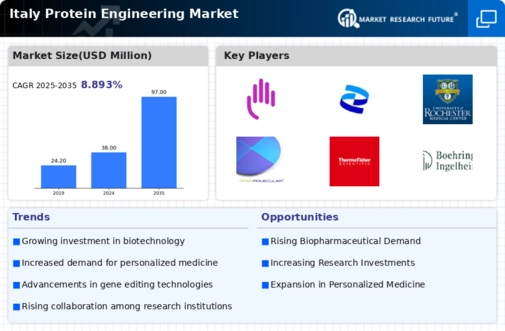Growing Biopharmaceutical Sector
The biopharmaceutical sector in Italy is experiencing notable growth, which is likely to drive the protein engineering market. With an increasing number of biopharmaceutical companies focusing on the development of therapeutic proteins, the demand for engineered proteins is expected to rise. In 2025, the biopharmaceutical market in Italy is projected to reach approximately €10 billion, reflecting a compound annual growth rate (CAGR) of around 8%. This growth is attributed to advancements in drug development and the increasing prevalence of chronic diseases. As biopharmaceutical companies seek to enhance the efficacy and safety of their products, the protein engineering market is positioned to benefit significantly from this trend, as engineered proteins play a crucial role in the development of innovative therapies.
Investment in Research and Development
Investment in research and development (R&D) within the life sciences sector in Italy is a critical driver for the protein engineering market. The Italian government and private entities are increasingly allocating funds to support R&D initiatives, which are essential for advancing protein engineering technologies. In 2025, R&D spending in the life sciences is expected to exceed €5 billion, indicating a strong commitment to innovation. This investment fosters collaboration between academic institutions and industry players, leading to the development of novel protein engineering techniques. As a result, the protein engineering market is likely to expand, driven by the continuous pursuit of new applications and improved methodologies in protein design and production.
Rising Demand for Sustainable Solutions
The increasing emphasis on sustainability in various industries is influencing the protein engineering market in Italy. Companies are seeking environmentally friendly alternatives to traditional protein production methods, which often involve significant resource consumption. The protein engineering market is responding to this demand by developing sustainable production techniques, such as microbial fermentation and plant-based systems. In 2025, it is estimated that the market for sustainable proteins will grow by 20%, driven by consumer preferences for eco-friendly products. This shift towards sustainability not only aligns with The protein engineering market as a key player in addressing environmental challenges while meeting the needs of diverse industries.
Regulatory Support for Biotech Innovations
Regulatory frameworks in Italy are evolving to support innovations in biotechnology, which is beneficial for the protein engineering market. The Italian Medicines Agency (AIFA) has been actively working to streamline the approval processes for biopharmaceutical products, thereby encouraging the development of engineered proteins. This regulatory support is crucial, as it reduces the time and costs associated with bringing new products to market. In 2025, it is anticipated that the number of approved biopharmaceuticals will increase by 15%, reflecting the positive impact of these regulatory changes. Consequently, the protein engineering market is likely to see accelerated growth as companies capitalize on the favorable regulatory environment to introduce innovative protein-based therapies.
Technological Advancements in Protein Design
Technological advancements in protein design are playing a pivotal role in shaping the protein engineering market in Italy. Innovations such as CRISPR gene editing, machine learning, and high-throughput screening are enabling researchers to create more efficient and effective engineered proteins. These technologies facilitate the rapid identification of desirable protein characteristics, significantly reducing the time required for development. In 2025, it is projected that the adoption of these advanced technologies will increase by 30%, further enhancing the capabilities of the protein engineering market. As a result, companies are likely to leverage these innovations to develop tailored protein solutions that meet specific industry needs, thereby driving market growth.






















Leave a Comment